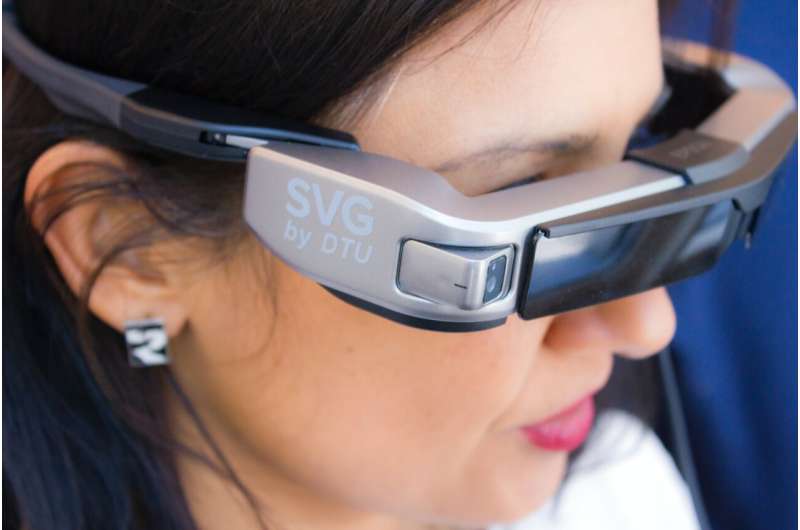This article has been reviewed according to Science X's editorial process and policies. Editors have highlighted the following attributes while ensuring the content's credibility:
fact-checked
trusted source
proofread
'Smart' glasses skew power balance with non-wearers, say researchers

Someone wearing augmented reality (AR) or "smart" glasses could be Googling your face, turning you into a cat or recording your conversation—and that creates a major power imbalance, said Cornell researchers.
Currently, most work on AR glasses focuses primarily on the experience of the wearer. Researchers from the Cornell Ann S. Bowers College of Computing and Information Science and Brown University teamed up to explore how this technology affects interactions between the wearer and another person. Their explorations showed that, while the device generally made the wearer less anxious, things weren't so rosy on the other side of the glasses.
Jenny Fu, a doctoral student in the field of information science, presented the findings in a new study, "Negotiating Dyadic Interactions through the Lens of Augmented Reality Glasses," at the 2023 ACM Designing Interactive Systems Conference in July.
AR glasses superimpose virtual objects and text over the field of view to create a mixed-reality world for the user. Some designs are big and bulky, but as AR technology advances, smart glasses are becoming indistinguishable from regular glasses, raising concerns that a wearer could be secretly recording someone or even generating deepfakes with their likeness.
For the new study, Fu and co-author Malte Jung, associate professor of information science and the Nancy H. '62 and Philip M. '62 Young Sesquicentennial Faculty Fellow, worked with Ji Won Chung, a doctoral student, and Jeff Huang, associate professor of computer science, both at Brown, and Zachary Deocadiz-Smith, an independent extended reality designer.
They observed five pairs of individuals—a wearer and a non-wearer—as each pair discussed a desert survival activity. The wearer received Spectacles, an AR glasses prototype on loan from Snap Inc., the company behind Snapchat. The Spectacles look like avant-garde sunglasses and, for the study, came equipped with a video camera and five custom filters that transformed the non-wearer into a deer, cat, bear, clown or pig-bunny.
Following the activity, the pairs engaged in a participatory design session where they discussed how AR glasses could be improved, both for the wearer and the non-wearer. The participants were also interviewed and asked to reflect on their experiences.
According to the wearers, the fun filters reduced their anxiety and put them at ease during the exercise. The non-wearers, however, reported feeling disempowered because they didn't know what was happening on the other side of the lenses. They were also upset that the filters robbed them of control over their own appearance. The possibility that the wearer could be secretly recording them without consent—especially when they didn't know what they looked like—also put the non-wearers at a disadvantage.
The non-wearers weren't completely powerless, however. A few demanded to know what the wearer was seeing, and moved their faces or bodies to evade the filters—giving them some control in negotiating their presence in the invisible mixed-reality world. "I think that's the biggest takeaway I have from this study: I'm more powerful than I thought I was," Fu said.
Another issue is that, like many AR glasses, Spectacles have darkened lenses so the wearer can see the projected virtual images. This lack of transparency also degraded the quality of the social interaction, the researchers reported.
"There is no direct eye contact, which makes people very confused, because they don't know where the person is looking," Fu said. "That makes their experiences of this conversation less pleasant, because the glasses blocked out all these nonverbal interactions."
To create more positive experiences for people on both sides of the lenses, the study participants proposed that smart glasses designers add a projection display and a recording indicator light, so people nearby will know what the wearer is seeing and recording.
Fu also suggests designers test out their glasses in a social environment and hold a participatory design process like the one in their study. Additionally, they should consider these video interactions as a data source, she said.
That way, non-wearers can have a voice in the creation of the impending mixed-reality world.
The findings are published as part of the Proceedings of the 2023 ACM Designing Interactive Systems Conference.
More information: Ji Won Chung et al, Negotiating Dyadic Interactions through the Lens of Augmented Reality Glasses, Proceedings of the 2023 ACM Designing Interactive Systems Conference (2023). DOI: 10.1145/3563657.3595967





















